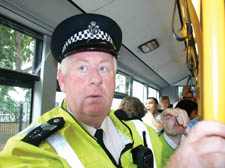|
|
 |
| |
 Sgt Greg Fox on the 29 bus during Operation Goldfinger Sgt Greg Fox on the 29 bus during Operation Goldfinger |
Hold tight for a ride on the bus they call the ‘Crazy Train’
‘Code red’ alerts on the 29 bus have shot up since a safety review was promised last year
YOU might expect the N29 night bus, packed with revellers returning from the clubs of the West End and the watering holes of Camden Town, to be filled with all-round bonhomie.
But there is no party on this route and it’s not just the sickly smell of kebabs and chilli sauce or the rowdy singing from the back seats that have left drivers and passengers in despair.
New figures released to the New Journal show that drivers of the night bus and its daytime equivalent, the 29, have pressed the emergency button more than 1,516 times in the past 12 months.
The “code red” incidents cover attacks on passengers, abuse directed at drivers and thefts. The figures easily outstrip last year’s tally of 742 “code reds” over a 12-month period.
This time last year, transport chiefs reacted to safety concerns with promises of a review. In the eyes of passengers, at least, whatever they have tried has backfired.
It is perhaps no surprise then that passengers have had enough of the service, now known as the “Crazy Train” for the wild behaviour of passengers and the fare-dodgers able to get on the bendy bus without showing a pass.
Under the two-week Operation Goldfinger, which ended on Friday, about 500 police officers patrolled 20 routes, including the 29. The hope was that the sight of police would reduce the fear of crime and give troublemakers a short sharp shock.
Passengers see the patrols as a temporary solution. They are fed up with the overcrowding and the growing feeling of unease as the bus snakes from the West End through Camden Town to Holloway and Finsbury Park.
When the New Journal covered two high-profile incidents on the bus last year – including a late-night stabbing and an attack on Les Incompetents musician Billy Leeson in Camden Road which left the singer in a coma with a fractured skull – transport chiefs talked about creating a 429 bus, which would begin its route in Camden Town.
It was seen as a way of solving the problems caused by buses arriving in Camden Town already full with passengers.
The idea has not yet been taken further but nobody seems able to explain the increase in emergency incidents on the bus, even accepting that not every “code red” is because of a stabbing or a full-blown fight. Sometimes the alerts are for traffic accidents or breakdowns.
But when the New Journal rode the bus this week it was clear passengers want Transport for London (TfL) to take action.
Steven Tyler, a bands booking agent, said: “We call it the Crazy Train, after the Ozzy Osbourne song. They’re a real death trap. I know at least 10 people who’ve had mobile phones robbed off them, because no one has to pay. I’ve also been on them when people have fainted. They’re a really harsh ride.”
Student Ruby Sabla, 19, once the victim of a pickpocket on the 29, said crime was rife on the route. “It’s easier to steal on the 29, she said. “On the Tube you’re underground and you have to run all the way to the exit. On the bus you just get off and you’re away. Nowadays it’s much rowdier because people can get on for free.”
Dan Green, 30, a sound editor from Turnpike Lane who takes the 29 to Camden Town every day, said the buses were too crowded. “They’re always ridiculously full. They try and squeeze too many people on,” he added. “I don’t know why it’s such a busy bus – maybe it’s because it’s a long route, or maybe it’s because people freeload.”
Lib Dem councillor Ben Rawlings, the Town Hall’s community safety chief, believes bendy buses encourage unruly behaviour. “If you treat people like cattle you’re encouraging a lower standard of behaviour,” he said.
Privately at least, there are people at TfL who think complaints stem from a nostalgia for the old Routemaster buses, which went out of service last year.
One insider said passengers simply needed to get used to the “new experience” offered by the bendy bus.
A spokesman said: “The likelihood of you being on a bus when there is anti-social behaviour is between one in 35,000 and 40,000 bus journeys.”
Jeroen Weimar, a TfL police director, added: “Initiatives such as Goldfinger show our commitment to cracking down on anti-social behaviour. We don’t want to stop young people from enjoying their journeys on our buses but this jointly led operation aims to stop the small minority of young people whose thoughtless behaviour disrupts the journey for others.”
The operation will re-start in September, to coincide with the new school term.
But the new “code red” figures tell their own story. Over the past 12 months, things have got worse.
For the 20 million-plus travellers who use the bus every year, the rise in alerts will be no surprise. |
 |
|
| |
| Your Comments: |
| |
| |
| |
|
 |
|